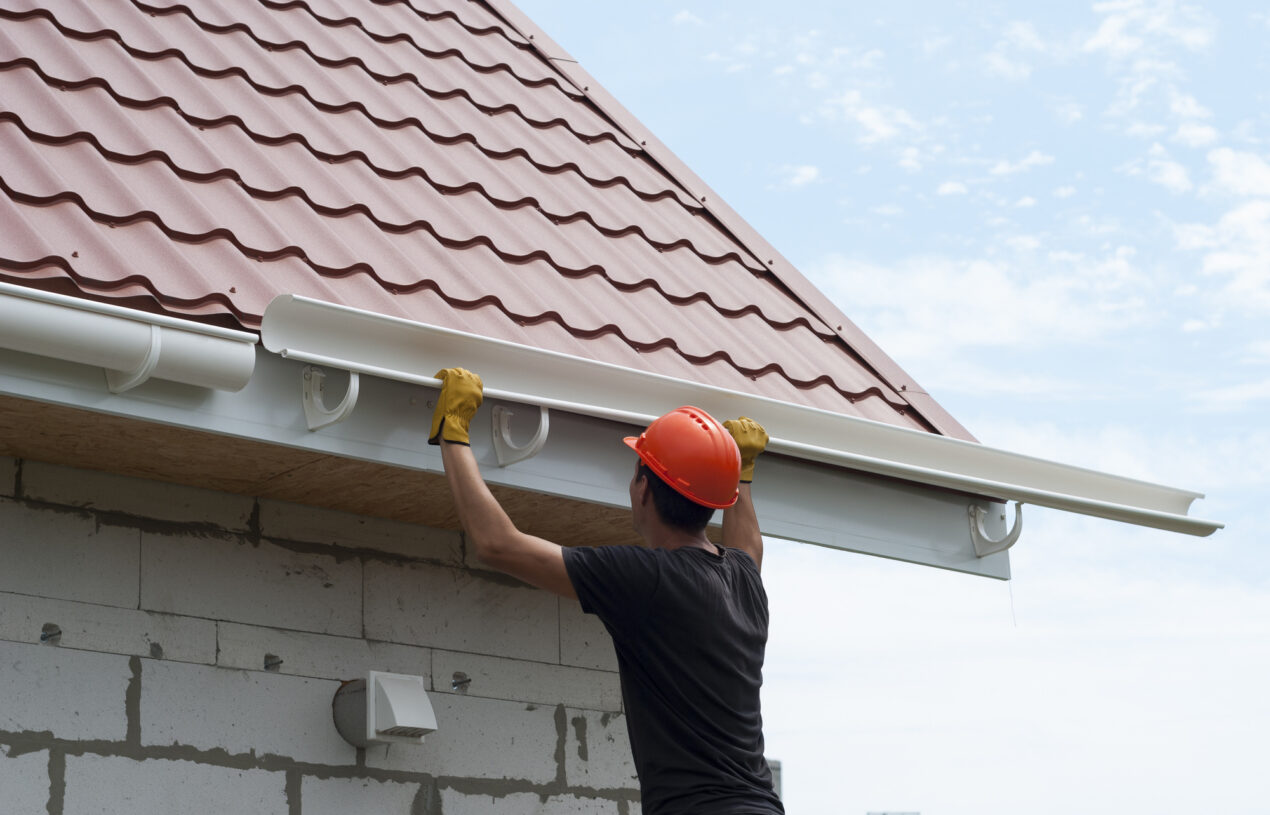Gutter installation is a crucial aspect of home maintenance, ensuring that rainwater is properly channeled away from your roof and foundation. When done correctly, gutters protect your home from water damage, mold, and erosion. However, even minor mistakes during installation can lead to serious issues down the line. Whether you’re a DIY enthusiast or hiring a professional, it’s important to understand the most common gutter installation mistakes and how to avoid them. Below are some of the top mistakes homeowners make during gutter installation and tips on how to prevent them.
1. Incorrect Gutter Slope
Why It’s a Problem:
Gutters are designed to direct water toward the downspouts, so it’s critical to install them with the proper slope. Without the correct angle, water will pool in certain areas, leading to blockages, rust, or even overflow during heavy rainfall.
How to Avoid It:
- Ensure that gutters slope approximately 1/4 inch for every 10 feet toward the downspouts. This is the ideal pitch to allow water to flow freely.
- Use a level or string to measure the slope during installation. Double-check the slope to avoid any low spots that could trap water.
- Pay attention to the pitch at both ends of the gutters, as even a slight deviation can cause drainage problems.
2. Not Using Enough Downspouts
Why It’s a Problem:
If your gutters don’t have enough downspouts, water can build up and overflow, leading to water damage on your home’s exterior, foundation, or landscaping. Overflows can also cause gutters to sag or pull away from the house.
How to Avoid It:
- Install at least one downspout for every 30-40 feet of gutter length, depending on the size of the gutter and the roof’s drainage needs.
- In areas with heavy rainfall or larger roofs, consider installing additional downspouts to ensure proper water flow.
- Use properly sized downspouts (typically 2×3 inches for standard homes, or 3×4 inches for larger properties) to handle the amount of rainwater expected.

3. Using Low-Quality Materials
Why It’s a Problem:
Choosing low-quality gutter materials can result in a variety of issues such as rust, corrosion, warping, or fading over time. Cheap gutters may also be more prone to clogging and may not last as long, leading to expensive repairs or replacements.
How to Avoid It:
- Choose high-quality materials that suit your local climate and the size of your home. Aluminum, copper, and steel are popular choices because they’re durable and resistant to weather damage.
- If you live in an area with heavy rainfall, consider investing in thicker gauge materials to ensure that your gutters can handle the extra water.
- Look for rust-resistant or powder-coated gutters to minimize the risk of corrosion.
4. Improper Fastening of Gutters
Why It’s a Problem:
Gutters that aren’t securely fastened to the house can sag, pull away, or even collapse. This not only affects the gutter system’s functionality but can also damage the roof or siding.
How to Avoid It:
- Use the correct type of gutter hangers or brackets to secure your gutters properly. The spacing between hangers should be no more than 24 inches apart to prevent sagging.
- Ensure the fasteners penetrate the fascia securely to hold the weight of the water-filled gutters.
- For heavier gutters or locations with strong winds, opt for stronger hangers or use additional fasteners for extra support.
5. Overlooking Gutter Guards
Why It’s a Problem:
Gutters without guards are more prone to clogging, especially with leaves, twigs, and other debris. Clogs can lead to overflow, water damage, and gutter system failure. Regular cleaning of gutters can be time-consuming, and neglecting it can shorten the lifespan of your gutters.
How to Avoid It:
- Install gutter guards or covers to prevent debris from entering your gutters in the first place. This will help reduce the need for frequent cleaning and keep your gutters working efficiently.
- Choose a guard type that matches your local climate and the types of debris common in your area. For example, fine mesh guards work well for areas with lots of small leaves, while solid covers may be better for larger debris like pine needles.
6. Not Taking Roof Type and Pitch Into Account
Why It’s a Problem:
Roof types, such as steep slopes or flat roofs, can affect the flow of water into your gutters. Failing to consider the roof pitch or design can lead to improper water collection or gutter overflow.
How to Avoid It:
- Make sure your gutters are properly sized for the amount of water expected from your roof. Steeper roofs or larger surfaces may need wider gutters or additional downspouts to handle the increased water flow.
- If you have a flat roof, ensure your gutters are positioned at the lowest point to capture water effectively. In these cases, you may need more frequent maintenance to prevent standing water from accumulating.
- Consider a professional assessment if your home has a complex roof design to ensure the gutter system is optimized for maximum water collection.
7. Not Sealing Joints Properly
Why It’s a Problem:
Gutter joints are vulnerable areas where water can leak out, especially if they’re not properly sealed. This can lead to water damage to the fascia, soffits, or siding and ultimately compromise the gutter system’s integrity.
How to Avoid It:
- Use high-quality sealant designed for gutters to seal all joints and seams. Ensure the sealant is compatible with the gutter material to prevent leaks.
- Apply the sealant generously, but avoid over-applying it, as excess sealant can attract dirt and debris.
- Check the joints periodically for leaks, especially after heavy rainfall, and reapply sealant as needed.
8. Incorrect Gutter Size
Why It’s a Problem:
Choosing gutters that are too small for your roof can result in overflow and ineffective drainage. On the other hand, overly large gutters can be costly and difficult to install, providing more capacity than necessary.
How to Avoid It:
- Ensure that you choose the right gutter size based on the size of your roof and the volume of rainfall in your area. Standard residential gutters are usually 5 inches wide, but larger homes or areas with heavy rainfall may require 6-inch gutters.
- Use a professional to determine the proper gutter size if you’re unsure about the right fit for your home.
9. Failing to Check the Roof’s Edge Before Installation
Why It’s a Problem:
If the edge of your roof is not properly aligned or sloped, it could cause problems with how water flows into the gutters. Uneven roof edges can lead to improper water collection and gutter overflow.
How to Avoid It:
- Before installing gutters, inspect the roof’s edge to ensure that it’s level and aligned. If the roof edge is not straight, water may pool and not flow directly into the gutters.
- In some cases, it may be necessary to adjust or trim the roof’s edge slightly to ensure a better fit for the gutters.
10. Skipping Professional Help When Needed
Why It’s a Problem:
While DIY gutter installation can be a cost-effective solution for some homeowners, gutter systems require precise installation. Improper installation can lead to ongoing issues that may be difficult or expensive to repair.
How to Avoid It:
- If you’re not confident in your DIY skills, consider hiring a professional to install your gutters. A professional will have the knowledge and tools to avoid common mistakes and ensure the job is done right.
- Hiring a professional also guarantees that the installation is compliant with local building codes and standards.
Final Thoughts
Proper gutter installation is vital for protecting your home from water damage and ensuring the longevity of your gutter system. By avoiding these common gutter installation mistakes—such as improper slope, insufficient downspouts, or using low-quality materials—you can ensure that your gutters function effectively for years to come. Whether you’re tackling the project yourself or working with a professional, attention to detail and proper planning are key to a successful installation. With the right approach, your gutters will provide the protection your home needs from rain and water damage.
